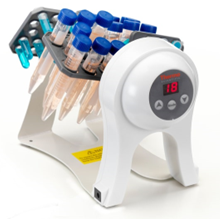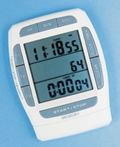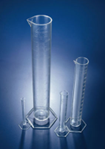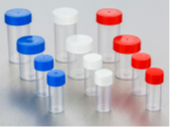This post discusses why we suggest the equipment we do.
Introduction
All OMMICA kits come with the test-tubes and reagents to run your test samples.
One of the aspects of the OMMICA assays which make them easy for the operator to use is that everything is done in the supplied test tubes; there is no need to transfer any liquids out of the tubes once they have been added.
However, some equipment is needed to run the tests, and there is recommended equipment that goes with it (which is listed on a downloadable document on the relevant website page).
These are readily available items (except for the custom rotator for the oven); so, although we are always happy to provide the equipment to a customer (either for sale or for rental), there is no necessity to do so if you already have that equipment, or something similar.
In all cases, the equipment we suggest is equipment that we use ourselves, and know to be reliable, easy to use, and to give good results. More details below on each piece of equipment, why we recommend it, and what would be a good alternative. We are always happy to send you an empty test-tube, so you can try it in equipment you may already have.
Spectrometer

A spectrometer is used for all OMMICA assays; without an accurate reading of the
absorbance (intensity of yellow colour) developed during the assay, the concentration of test species cannot be determined.
For the assays which include a calculation spreadsheet (methanol and MEG), the spectrometer used should be able to read the 16 mm diameter test tubes supplied with the OMMICA kits, for the spreadsheet to work properly.
The model we recommend is the Hach DR900. This has the benefits of being compact, portable, and very easy to use, as well as taking the correct size tubes, and being able to read at the specified wavelength.
An alternative portable model is the Orion AQ3700. This also works well, but is slightly less user-friendly than the DR900.
Benchtop machines may also be used if they can take the 16 mm diameter test tubes (either directly or with an adapter). The US models of the Hach DR3900, or the (now discontinued) DR2800 work well, but the UK/EU models don’t have the option to take the 16 mm tubes. We have a list of which part numbers are suitable, and which aren’t, if you need to check with us if your instrument is one that will work.
Heater
All OMMICA assays require incubation at 50 °C.
When testing water samples, it doesn’t matter what format the heater is in: it can be a water-bath, oven, or dry bath with blocks. All that matters is that it can hold a steady temperature over an hour or so, and take the 16 mm diameter test-tubes. We supply a dry bath with suitably sized blocks, as this is the most compact option.
For the methanol and MEG assays, the heater should be able to take 5 tubes simultaneously (as there are 5 points in the standard curve).
When testing oil samples, it is necessary to have a heating device that can also provide end-over-end mixing of the tubes, as the extraction/reaction processes take place simultaneously (instead of first doing a manual water extraction of the oil sample, then analysing the water extract, as other assays often require).
The HB500 rotator oven with custom 3D-printed tube holder that we recommend is the most compact all-in-one unit that we have found which can provide the combination of steady end-over-end mixing and stable heating at 50 °C.
An alternative is a tube revolver which can then be placed inside a standard oven (such as the one shown): this requires approximately 25 x 25 x 25 cm space in the oven, so is overall a less compact option than the rotator oven, but is a lower cost alternative if you already have an oven with free space in that you can leave set at 50 °C.
Centrifuge

Only the oil tests use a centrifuge, to separate the oil from the water layers at the end of the assay, so the tube can then be read in the spectrometer.
The centrifuge should have adjustable speed; if it’s set at more than 1800 rcf (usually between 3000 and 4000 rpm in a benchtop centrifuge), then there’s a risk that the tubes will break. Which can leave a mess to clean up, and lose the data point, as well as potentially damaging the centrifuge!
Example models include the Thermo Fisher Medifuge, the VWR Compact Star CS8 (shown), the Eppendorf 5702 etc.
Many compact benchtop centrifuges are suitable, as long as they have a rotor that can take the 16 mm diameter test tubes (these are an equivalent diameter to 15 mL Falcon tubes, so if your centrifuge can take these, you should be OK).
Pipettes

All OMMICA tests need precision pipettes to accurately dispense all the liquid volumes. For assays which only use aqueous liquids (the THPS, MEG in water, and methanol in water options), any precision pipettes which cover the volume range required may be used. If air pipettes are used, it may be necessary to use more than one to cover the entire volume range required; for example a 10 mL and a 1 mL pipette.
For assays which test oil samples, positive displacement pipettes are very strongly recommended in order to get accurate measurement of the oil samples. These include electronic repeater pipettes like the Eppendorf E3 (the one OMMICA will supply if one is ordered), the Brand “HandyStep touch” model, or similar; as well as single dispense pipettes like the Gilson Microman models.
The advantage of the electronic repeater pipettes is that they can dispense all volumes needed in the kits, with the same pipette, just changing the tip size used, so only a single pipette is needed. Manual repeater pipettes (like the Eppendorf M4) as well as the Microman type aren’t as versatile, so more than one pipette may be needed to cover all the volumes used.
For analysis laboratories with a large range of pipettes, there are likely to be all the sizes needed, but for offshore or satellite installations, where they aren’t available, the E3 is easier. It is also very reproducible, and easy for people less experienced with pipettes to use.
Optional extras and consumables
Apart from pipette tips and water, all the materials necessary to run any OMMICA assay are supplied in the kit boxes.
If you need pipette tips, we can supply them (the Combitips that go with the Eppendorf Multipette models, or the regular tips for 10 mL, 5 mL and 1 mL air pipettes), just ask us to quote for these when you are ordering your kits.
For water, we recommend that you use purified water, as it gives better accuracy. Any type of purified water is fine; whether deionised, distilled, RO, MilliQ, etc. Water designed for car battery top-ups is a good option if you don’t have another supply.
However, there are some additional bits and pieces which can make your life easier.
Timer: all the assays have timed stages. In case you aren’t able to have your phone in the lab, any timer which can go up to an hour will be fine; such as a lab digital timer, or a kitchen timer
Test tube rack; the tube section in the kit box works OK, but if you’re running a lot of samples together, a rack might make it easier to manage them
Measuring cylinder; the MEG and THPS assays have a solid component which you make up by adding a measured volume of water before use. A measuring cylinder or serological pipette would both be ideal for this.
Dilution containers; if you’re analysing high concentration samples which need to be diluted before analysis, then having some disposable containers to do the dilution in can be useful; such as Falcon tubes or polypropylene screw cap containers.












Comments